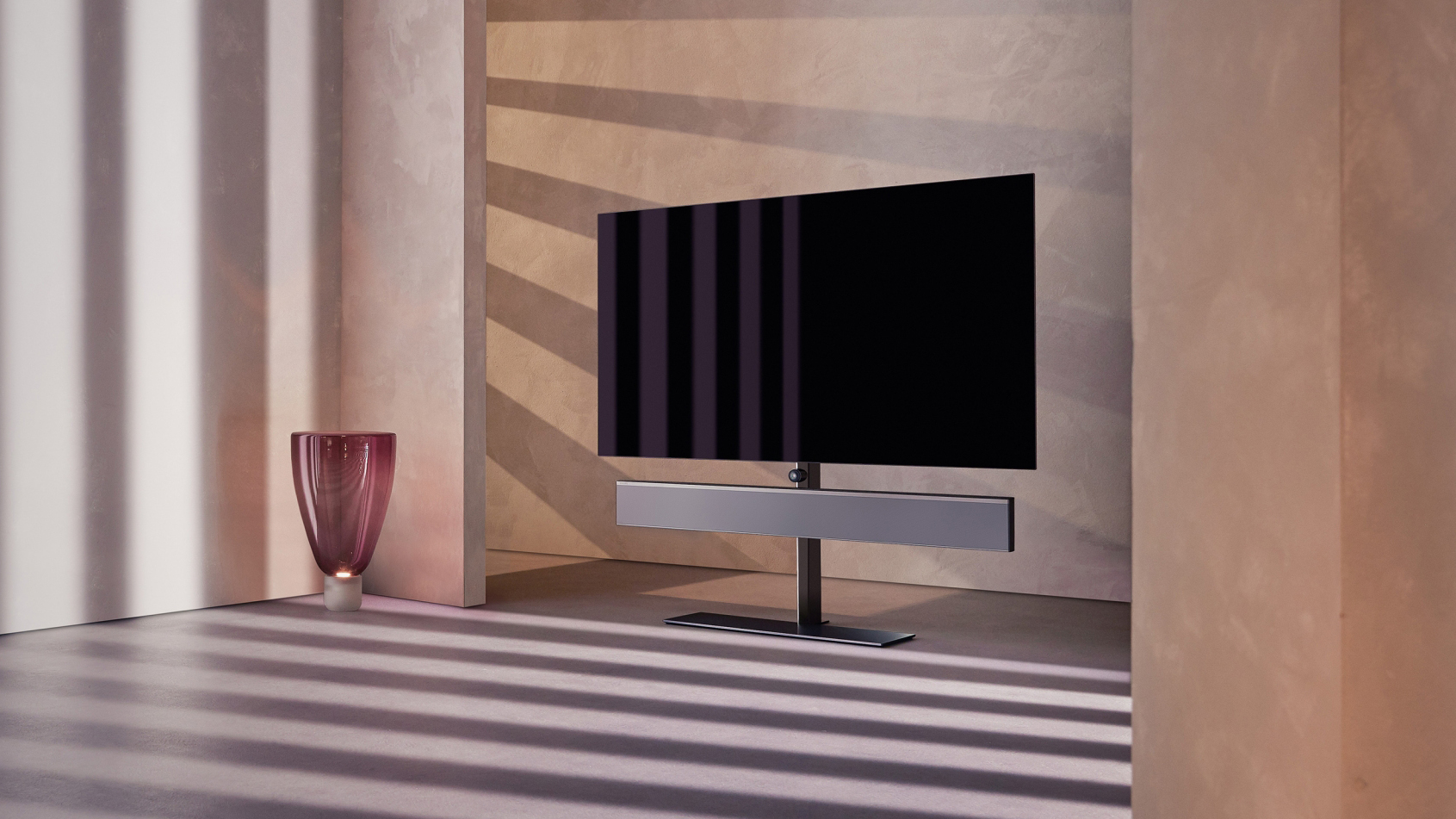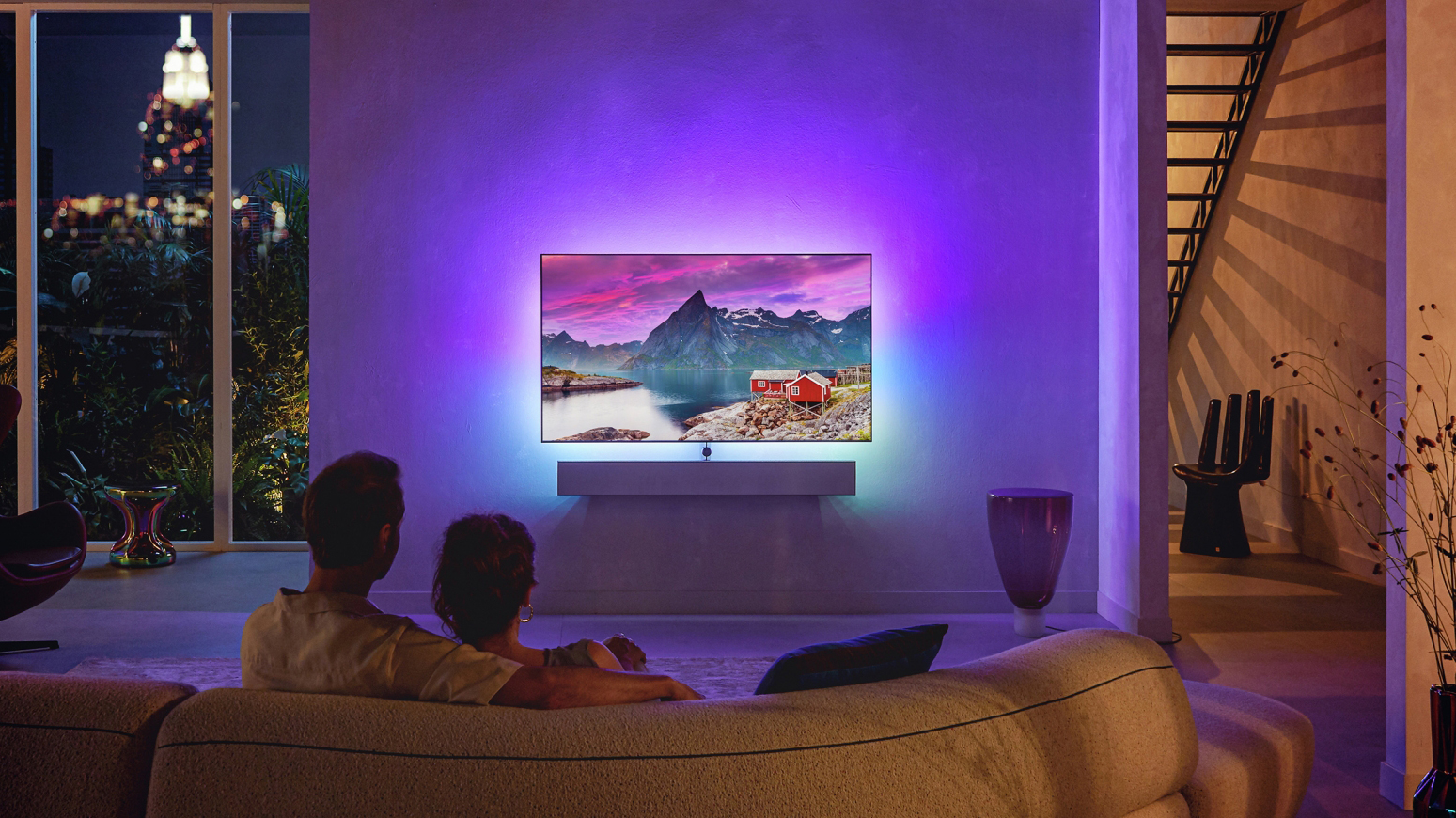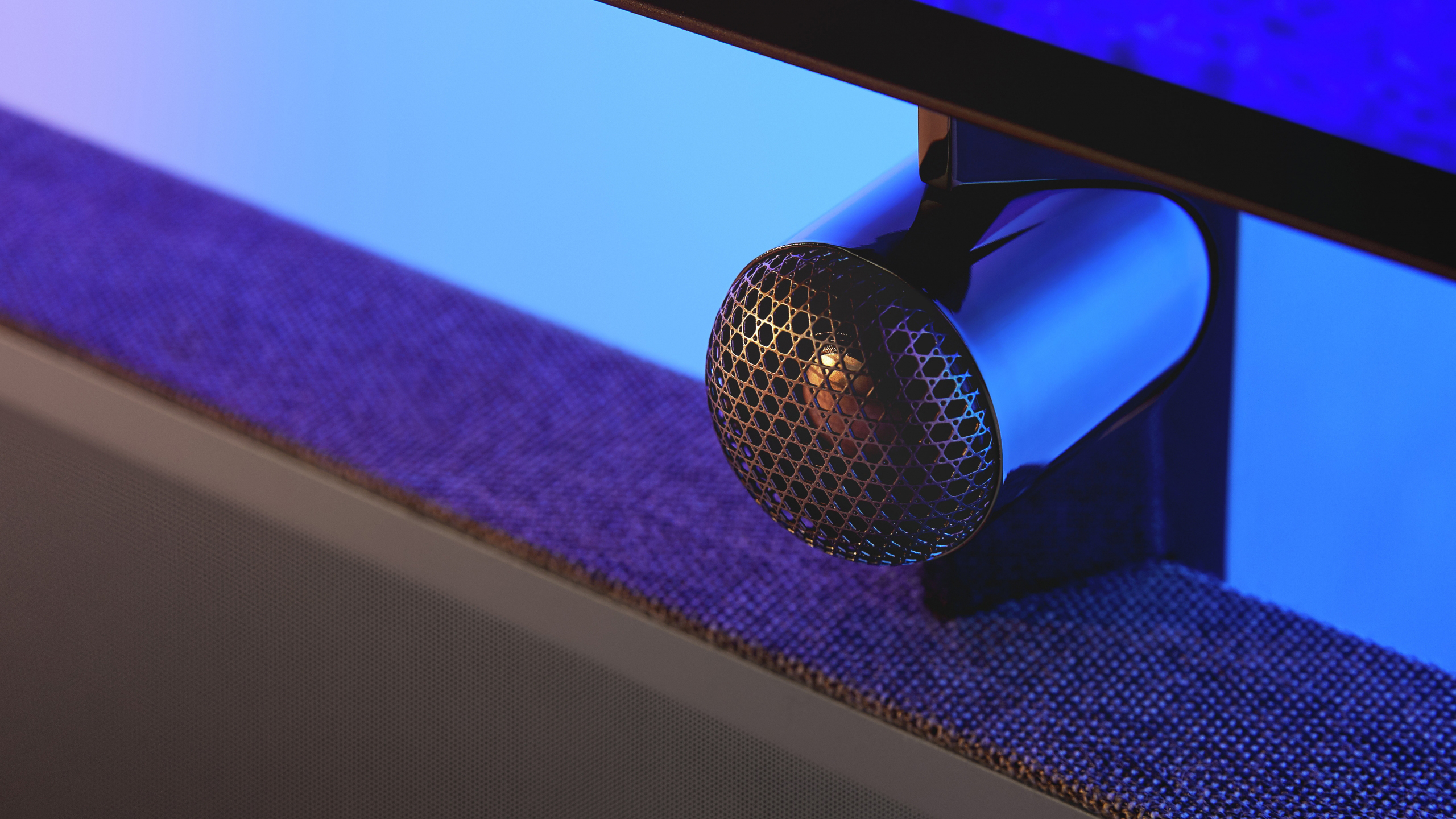Philips OLED+986 review
The Philips 65OLED986 delivers a stunning OLED TV and Bowers & Wilkins Dolby Atmos sound system in a single, great-looking package – it's the ultimate lifestyle TV



The Philips OLED+986 is an epically accomplished television where pictures and sound are concerned, even if it takes some time in the settings to get there. It obviously won't be for everyone, but it's exquisitely well-tuned for its intended audience.
-
+
Superlative combination of sound and vision
-
+
Ambilight, as usual, is a delight
-
+
Impressive perceived value
-
-
Better with movies than with games
-
-
Only in 65-inch size… and it's a big one
-
-
Need to fiddle in settings for best results
Why you can trust T3

The Philips OLED+986 is the new top-of-the-line OLED TV from a company that's been… well, to call it 'on a roll' is a slightly weak way of describing the adventure Philips has been on with its TV ranges lately.
In this Philips OLED+986 review, we're looking at a high-end TV and speaker system combination that's obviously designed to maintain that momentum, by packing in elite panel and processing tech to match any of the best OLED TVs, as well as custom-made sound setup from hi-fi legends Bowers & Wilkins.
Available only in a 65-inch form (officially the 65OLED986), the Philips OLED+986 wants to give you a complete home cinema upgrade from a single box – in a design that will look great in any home. You can wall mount the TV and speaker combo together, or use the floorstand it comes with to show its full design flourishes.
The fantastic image quality, unmatched sound and excellent overall spec mean that this in winner without question… but it comes at a high price. No two ways about it, nearly £4,000 is an awful lot for a television, even if it's one of the best 65-inch TVs available today. Can it possibly be worth the outlay? Well, yes, you've seen the score already, so let's dig into why.
Philips OLED+986 review: price & release date
The Philips OLED+986 was released in March 2022, and the sole 65-inch version sells for £3,999 or something very like it. Certainly you should count yourself lucky if you find any sort of meaningful discount – this isn't the kind of thing Philips is planning to stack high in warehouses and sell off.
Ordinarily this is where we tell you how much customers in other territories ought to expect to pay. Folks in Europe should be ready to part with €4,299 or thereabouts… but while Philips' OLED TVs are available in Australia, this set doesn't have confirmation of availability there yet.
And as far as American buyers are concerned, it's unlikely to be released there at all – Philips doesn't currently sell its OLED TVs there.
Get all the latest news, reviews, deals and buying guides on gorgeous tech, home and active products from the T3 experts
This is obviously a very premium price for the TV, but it's not out of line with the competition when you bear the sound system in mind. The Bang & Olufsen Beosound Stage is an equivalent kind of soundbar, and that costs £1,300 on its own. The 65-inch LG C2 OLED TV costs £2,700. So combine the two and you've got the same price as this – but you don't get a swish floorstand in that case…

Philips OLED+986 review: features & what's new
- Brighter OLED screen and top-tier processing
- Ambilight makes the picture feel even bigger
- High-end speaker system is part of the package
As befits a range-topping TV with a significant price-tag, the 65OLED986 is what the motor industry likes to call ‘fully loaded’.
For starters, Philips has continued to demonstrate that it’s one of the few grown-up companies in TV-land by making the OLED+986 compatible with every worthwhile HDR standard. Dolby Vision, HDR10+ and HDR10+ Adaptive are all available, and Xbox Series X owners will be particularly pleased with the Dolby Vision Game mode.
On the subject of gaming, two of the OLED+986’s four HDMI inputs are of the HDMI 2.1 standard, which means support for ALLM, VRR, HGiG, and – up to a point – 4K 120Hz. Which is to say the Philips can receive a 4K 120Hz signal but will cut the resolution in half before displaying it, frustratingly. The 986’s twin-chip processor is apparently to blame – Philips has prioritised movie performance over gaming performance, and this (as far as gaming goes) is the result. So while it has good gaming features overall, it's not the best gaming TV out there.
This twin-chip version of the P5 (Gen 5) processing engine is in charge of one of last year’s extra-bright LG OLED panels – the company reckons they’re a good 20% brighter than those that went before it.
And as is usual with Philips, it’s augmented by Ambilight, here in a four-sided implementation. If you know about Ambilight, you know its value – and if you don’t, well, read on. Unique features are rare where televisions are concerned, and genuinely effective unique features are rarer still.
Ambilight is fundamentally a strip of LEDs arranged on the rear panel of the television – and here it’s on each vertical and each horizontal axis. Its job is to beam light onto the surface behind the TV, it can be told to deliver a single colour, but mostly you'll want it to follow the colours of the images being displayed on the screen itself.
When written down it can seem gimmicky or contrived, but in practice it works splendidly. Images appear even bigger and more immersive than they otherwise would, and the overall viewing experience is more restful and easier on the eye. It’s an excellent feature, and we have to assume the Philips' patent is absolutely watertight – otherwise we can’t think of a reason other manufacturers wouldn’t want a piece of the action. Once you try it, it's hard to want to watch without it.
As far as sound goes, it’s apparent something is afoot before you even hear the OLED+986 in action. The collaboration between Philips and Bowers & Wilkins has borne very listenable fruit before now, and with this screen the boat has been pushed out yet further.
Behind the perforated steel grille of the integrated sound system there are three mid/bass drivers and a couple of tweeters, with a third in the classic ‘tweeter on top’ position B&W has been refining for ages. The mid/bass drivers are made of Continuum, the woven material used for the company’s flagship 800-series loudspeakers, and the exposed tweeter features a Nautilus tube in an effort to reduce the influence of backward-travelling sound.
All of the drivers face forwards, rather than firing in all directions in an attempt to deliver an impression of spatial audio, as is usually the style these days. But improved crossovers, upgraded amplifiers and fettled motor assemblies all speak of just how serious-minded a feature this is.

Philips OLED+986 review: picture quality
- Lush and natural colours, plus deep OLED black tones
- Superb detail and motion – even when upscaling
- You'll need to tweak the settings to get the best from it
There’s ‘extensive’, and then there’s the amount of work the user needs to put in when setting up the OLED+986 in order to get the best out of it. ‘Philips TV has labyrinthine menu system’ is hardly news to TV nerds, but it’s undeniable that no TV from any other brand lives or dies by the way its owner has set it up like a Philips. Be prepared to set some time aside if you want to see what this television is capable of.
And believe me, investing the time is well worth it. Straight out of the box, the OLED+986 looks lurid, sharp to the point of abrasive and retina-searingly bright. This last issue at least bodes well for the brightness claims made for this panel, but in its box-fresh state the Philips presents itself as the visual equivalent of being shouted at.
Get the settings just so, though, and the story is very different. Given some 4K Dolby Vision-assisted content to work with, the OLED+986 displays a master's hand: edge definition is smooth and believable, the colour palette is wide-ranging and naturalistic, motion is controlled with unshakeable authority, and detail levels are stratospheric.
The panel, sure enough, is obviously and demonstrably brighter than that of the old Philips OLED984 that this replaces – and when combined with the usual lustrously deep black tones of OLED, the resulting contrasts are wide and convincing.
There’s a sumptuousness to the images the Philips generates, but that’s not to be confused with lushness or an overdose of warmth… rather, it’s almost luxurious in its realism. Depth of field is similarly impressive, and the OLED+986 is capable of properly solidity of image even when it’s describing subtleties of shade or texture. And even after a thorough investigation of and fiddle with the set-up menus, the picture is plenty sharp enough thanks very much.
Upscaled content is equally susceptible to the OLED+986’s excesses of sharpness and luridity, but they too can be toned down. And once you’ve done so, virtually all of the positives that apply to native 4K HDR images apply here too. Admittedly detail levels are slightly less zealous, and edge definition is a little less one-stroke, but in overall terms the Philips is still a tremendous watch. The breadth and variation of its contrasts, the expansiveness of its colour palette, and its absolute positivity where motion is concerned, all combine to make it about as enjoyable a way to watch upscaled content as currently exists.

Philips OLED+986 review: sound quality
- Full range of sound without subwoofer
- Wide and detailed soundstage
Having knocked it out of the park where picture performance is concerned, the Philips fetches it back and promptly hits it even further where sound is concerned.
The Bowers & Wilkins system is, in simple terms, the best audio system a television has ever been fitted with. Despite making no meaningful attempt to force an impression of virtual surround sound from a Dolby Atmos soundtrack, it’s a robust, expansive, balanced system that does its thing with complete certainty.
It creates a wide, deep soundstage, locks information on it unshakeably, and serves up the finest details without forgetting that the overall presentation is what’s important.
Its tonality is exquisitely judged, its attack and dynamism are unquestionable, and its low-frequency presence and control is little short of startling. Can you name another TV that can happily give you the cinematic audio goods without need of a subwoofer? No, us neither.

Philips OLED+986 review: design & usability
- Comes with floorstand, or can be wall-mounted
- Fetching design of stand and speaker unit
- Android TV is great for features, but not super-intuitive
As far as design goes, the OLED+986 is just a little out of the ordinary. And that’s by Philips standards, which are a little out of the ordinary at the best of times.
To be fair, as far as the ‘screen’ portion goes, there’s not a lot to unnerve anyone here. This is (obviously) a big screen, with slender bezels across all four sides. It’s got the usual OLED ‘super-slim until it isn’t’ depth, increased just slightly more than is usual by the four-sided Ambilight. Below the bottom of the screen, though, things take a decisive turn.
The OLED+986 is supplied with a two-piece stand. If you want it to stand the TV on the floor, you’ll need both pieces; if it’s being wall-mounted, you only require the first piece. Either way, you’ll need to attach a hefty Bowers & Wilkins’ branded speaker enclosure. It’s a big unit, featuring all those drivers we mentioned – but its bulk is minimised somewhat by the very pleasing perforated-steel-and-Kvadrat-acoustic-cloth of its finish. The exposed driver above the main cabinet is one of B&W’s signature ‘tweeter on top’ items.
As far as usability goes, well, this is a Philips TV – which means you’ll take a dive into the menus in order to achieve the sort of barnstorming picture quality we’ve been enthusing about. The on-screen menus themselves are legible and sensible enough – there’s just a lot of them. Sub-menus are even more extensive. Fortunately the leather-backed remote control handset is logical enough in terms of layout, and the backlighting helps a fair bit too.
Away from the endless set-up menus, the Android smart TV interface is, as per usual, chock-full of useful apps, features Freeview Play and laid out seemingly at random. Philips hasn't announced any plans to move to the more inviting Google TV interface as yet.
Disney+ is currently having an Android TV-related tantrum about delivering Dolby Atmos and/or Dolby Vision, but otherwise the OLED+986 allows you to access the best of what every other service has to offer.
Philips OLED+986 review: verdict
High-end home cinema performance doesn’t usually come out of just one box – but this a simple way to get class-leading visuals and sound in one go.
Well, relatively simple – the Philips requires some hands-on assistance to get its pictures to their best, but the results are gratifying in the extreme.
Of course, being only available as a very high-end 65-inch set will rule out some people for this, but for those who it suits, it's an absolutely exceptional buy.
Philips OLED+986 review: also consider
If you like the concept here but need something smaller and/or that can go on a TV bench, take a look at the Philips OLED936. It's the same concept of a TV paired with a Bowers & Wilkins sound system, but it comes in more sizes, and the audio system is built into a more regular stand design. The screen and picture quality are at the same level, but the audio system is less advanced. Here's our full Philips OLED+936 review.
If you'd like the best picture quality possible from an OLED TV right now in a similarly premium lifestyle design, but without the big built-in sound system, the LG G2 is very much worth a look. It features the brightest OLED panel for regular movie use we've seen at the time of writing, and LG's fantastic next-gen image processing – all in a uniformly thin design that mounts flush on the wall. Here's our full LG G2 review.
Samsung's ongoing lack of Dolby Vision support looks more wilful by the day, but the company nevertheless knows precisely what it’s doing – and the new Samsung QN95B is an extremely accomplished TV. The design is good, the sound is good (although far from the standards set by the OLED+986), and the mini-LED pictures are almost comically good. Expensive, yes, but still usefully more affordable than the Philips. Here's our full Samsung QN95B review.
Simon Lucas is a freelance technology journalist and consultant, with particular emphasis on the audio/video aspects of home entertainment. Before embracing the carefree life of the freelancer, he was editor of What Hi-Fi? magazine and website – since then, he's written for titles such as Wired, Metro, the Guardian and Stuff, among many others. Should he find himself with a spare moment, Simon likes nothing more than publishing and then quickly deleting tweets about the state of the nation (in general), the state of Aston Villa (in particular) and the state of his partner's cat.
